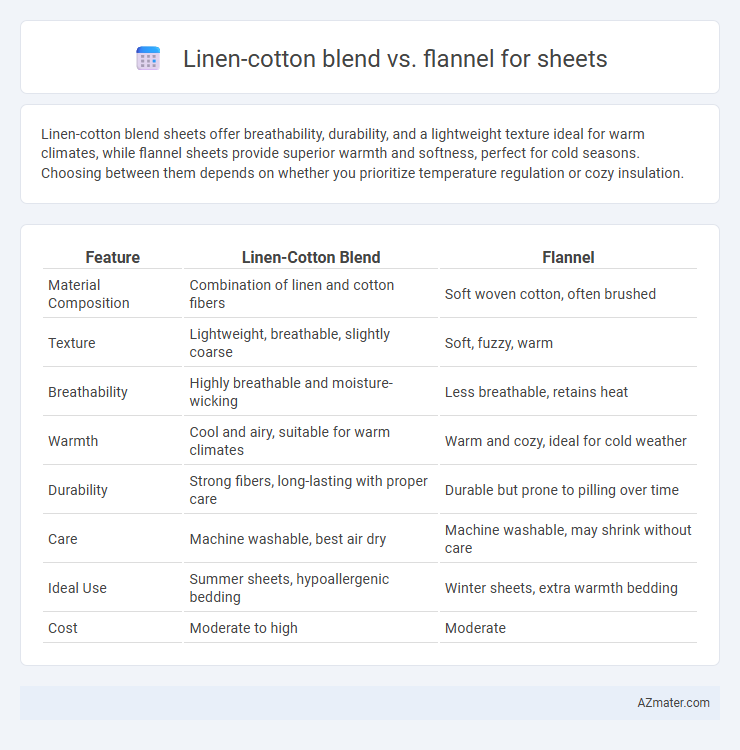Linen-cotton blend sheets offer breathability, durability, and a lightweight texture ideal for warm climates, while flannel sheets provide superior warmth and softness, perfect for cold seasons. Choosing between them depends on whether you prioritize temperature regulation or cozy insulation.
Table of Comparison
| Feature | Linen-Cotton Blend | Flannel |
|---|---|---|
| Material Composition | Combination of linen and cotton fibers | Soft woven cotton, often brushed |
| Texture | Lightweight, breathable, slightly coarse | Soft, fuzzy, warm |
| Breathability | Highly breathable and moisture-wicking | Less breathable, retains heat |
| Warmth | Cool and airy, suitable for warm climates | Warm and cozy, ideal for cold weather |
| Durability | Strong fibers, long-lasting with proper care | Durable but prone to pilling over time |
| Care | Machine washable, best air dry | Machine washable, may shrink without care |
| Ideal Use | Summer sheets, hypoallergenic bedding | Winter sheets, extra warmth bedding |
| Cost | Moderate to high | Moderate |
Introduction to Linen-Cotton Blend and Flannel Sheets
Linen-cotton blend sheets combine the breathability and moisture-wicking properties of linen with the softness and durability of cotton, creating a lightweight and comfortable fabric ideal for warm climates. Flannel sheets, crafted from tightly woven cotton fibers brushed to create a fuzzy texture, provide superior warmth and coziness, making them perfect for colder seasons. Both fabric types offer unique benefits: linen-cotton blends excel in temperature regulation and longevity, while flannel sheets prioritize insulation and softness.
Fabric Composition and Texture Comparison
Linen-cotton blend sheets combine approximately 50-70% linen with 30-50% cotton, offering a breathable, smooth fabric with a natural luster and a slightly crisp texture that softens over time. Flannel sheets are typically made from 100% cotton or a cotton-polyester blend and feature a napped surface that provides a warm, fuzzy texture perfect for colder climates. The linen-cotton blend excels in moisture-wicking and durability, while flannel sheets prioritize insulation and softness through their brushed fabric composition.
Breathability and Temperature Regulation
Linen-cotton blend sheets excel in breathability due to linen's natural moisture-wicking properties combined with cotton's softness, making them ideal for maintaining a cool and airy sleep environment. Flannel sheets, made from brushed cotton or wool, provide superior warmth by trapping heat close to the body, which is beneficial for colder seasons but less effective for temperature regulation in warm climates. Choosing between linen-cotton blend and flannel depends on desired thermal comfort, with linen-cotton offering optimal airflow and flannel prioritizing insulation.
Durability and Longevity of Each Material
Linen-cotton blend sheets combine the strength of linen fibers with the softness of cotton, resulting in durable bedding that resists wear and maintains shape over time. Flannel sheets, made from brushed cotton or wool, offer warmth and comfort but may experience pilling and fabric thinning with prolonged use. The linen-cotton blend's natural moisture-wicking and breathable properties contribute to its longevity, making it a more resilient choice compared to the typically cozy yet less durable flannel.
Comfort and Softness: What to Expect
A linen-cotton blend sheet offers a breathable and lightweight feel with natural moisture-wicking properties, providing comfort especially in warmer climates. Flannel sheets deliver superior softness and warmth due to their brushed fibers, making them ideal for colder seasons and cozy sleeping environments. Expect linen-cotton blends to become softer with each wash, while flannel maintains a consistently plush texture.
Maintenance and Care Requirements
Linen-cotton blend sheets require gentle washing in cold water and air drying to maintain fiber strength and prevent shrinkage, while flannel sheets need frequent washing in warm water to remove pilling and maintain softness. Linen-cotton blends benefit from occasional ironing to keep the fabric smooth, whereas flannel sheets tend to soften over time with consistent use and low-heat tumble drying. Proper care for both fabrics ensures durability, with linen-cotton blends offering breathability and flannel providing warmth.
Allergen Friendliness and Skin Sensitivity
Linen-cotton blend sheets offer superior breathability and moisture-wicking properties, making them ideal for individuals with sensitive skin or allergen concerns by reducing the risk of irritation and promoting a hypoallergenic sleep environment. Flannel sheets, while soft and warm due to their brushed fibers, may trap more allergens like dust mites and fibers, potentially aggravating skin sensitivities and allergies. Choosing linen-cotton blends ensures enhanced airflow and durability, fostering a cleaner, more skin-friendly bedding option compared to the cozier yet allergen-prone flannel fabric.
Seasonal Suitability: Best Times to Use Each
Linen-cotton blend sheets excel in warm weather due to their breathability and moisture-wicking properties, making them ideal for spring and summer use. Flannel sheets provide superior warmth and insulation, perfect for colder seasons like fall and winter. Choosing the right fabric ensures optimal comfort by matching the sheet material to seasonal temperature fluctuations.
Aesthetic Appeal and Style Options
Linen-cotton blend sheets offer a natural, textured aesthetic with a breathable, slightly crisp hand that enhances minimalist and rustic bedroom styles. Flannel sheets provide a cozy, plush appearance with a brushed surface, ideal for creating warm, inviting, and traditional ambiance during colder months. Both fabrics come in diverse color palettes and patterns, but linen-cotton blends tend to favor muted, earthy tones, while flannel excels in vibrant plaids and checks.
Value for Money: Price and Affordability
Linen-cotton blend sheets offer excellent durability and breathability at a moderate price point, making them a cost-effective choice for long-term use. Flannel sheets tend to be more affordable initially, providing warmth and softness ideal for colder climates but may wear out faster over time. Evaluating value for money depends on prioritizing either the long-lasting quality and moisture-wicking properties of linen-cotton blends or the budget-friendly comfort of flannel options.

Infographic: Linen-cotton blend vs Flannel for Sheet
 azmater.com
azmater.com